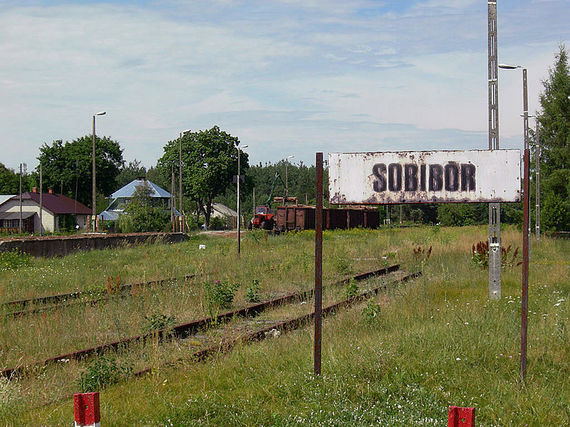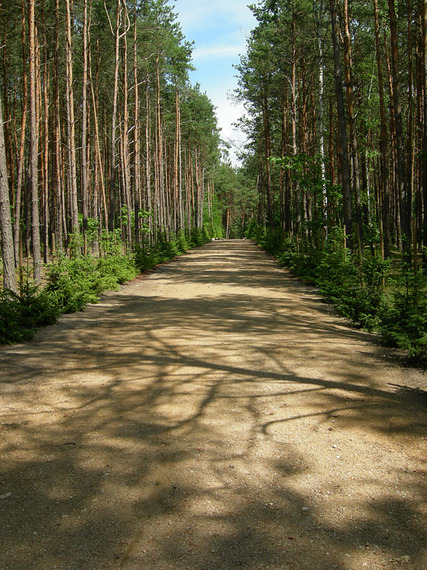"Sobibór 'Himmelstrasse'," by Jacques Lahitte
It was many years ago when I first heard about a Nazi death camp named Sobibór, nestled deep in the forests of the Lublin district of South-Eastern Poland.
Sobibór was one of three Nazi extermination camps -- the other two were Belzek and Treblinka -- that had received little notoriety compared to camps such as Auschwitz-Birkenau, even though an estimated 1.4 million Jews were annihilated at the three camps, more than at Auschwitz-Birkenau.
The Sobibór death camp was one of the Nazis' best-kept secrets. Even in the Netherlands, the existence and the history of Sobibór were not widely known.
That is surprising, because of the estimated 170,000 to 250,000 Jews and Roma who were systematically murdered at Sobibór over a short 18-month period, more than 34,000 were Dutch Jews. The Dutch newspaper, the NRC Handelsblad, called Sobibór the "Dutch Auschwitz."
It wasn't until several years ago that Sobibór acquired a personal, sinister significance to me.
A Dutch uncle, Jan Roeland van Wisse de Wind, spent the last few years of his life researching and documenting the de Wind genealogy.
When I received a copy, I was not only struck by the number of de Winds and de Wind relatives who had been transported by the Nazis to various concentration camps, but also by how many of those lives were ended by Nazi murderers at that "little-known" camp, Sobibór.
Of the more than 100 de Wind family members who lost their lives at Nazi extermination camps, 22 were murdered in the gas chambers of Sobibór. The youngest, Hella Brechnel de Wind, was a mere 10-years-old, the oldest, Helena de Wind, was 67.
But, even after the evil purpose of Sobibór began to sink in, the remnants of that camp and its almost idyllic surroundings did not seem to match the cruel reality of some 70 years ago.
Five years ago, I quoted NRC Handelsblad's correspondent Stéphane Alonso's description of Sobibór and surroundings:
There is little in Sobibór to remind one of the former extermination camp... Anyone who didn't know better would think they are in a typical Polish hamlet, where clean washing flutters in the wind, farmers on old tractors rumble by and lumbermen lug tree trunks.
When I recounted my fist impressions of the camp and surroundings, I also was taken in by the serene images, especially by the photo of "Himmelfahrtstrasse" -- the "road to heaven."
I wrote, "Perhaps it was the accompanying photograph of a blissful, peaceful, country path bordered on both sides by tall pine trees" that softened the impact of reading about such a ghastly place.
I learned that, in 1942 and 1943, this idyllic-looking "road to heaven" led to several gas chambers where the Nazis practiced their "Final Solution," the "Endlösung der Judenfrage."
Even several rusty railroad tracks, now overgrown with grass and weeds, and an equally rusty station sign with the single word "Sobibór" still standing across from the crumbling station platform looked innocuous enough.

Railroad tracks at Sobibor death camp, circa 2007. "Gare de Sobibor" by Jacques Lahitte.
However, these were the tracks over which dozens upon dozens of "train transports," essentially cattle cars crammed with Jewish victims, came to a final stop after tortuous journeys from Westerbork in the Netherlands -- a grueling 72- hour journey -- and from various locations in Poland and Germany.
The men, women and children were then made to walk -- naked, as they were told they were going to take showers -- down the 300-yard long Himmelfahrtstrasse to the gas chambers and to their deaths.
Yes, the Nazis knew how to erase all traces -- virtually all -- of their heinous crimes and how to keep a secret.
On October 4, 1943, speaking to his senior SS henchmen in Poznan and referring to "the extermination of the Jewish people," Reichsführer-SS Heinrich Himmler said, "This is an unwritten and never-to-be-written page of glory in our history..."
And the Nazis certainly succeeded in keeping the Sobibór paragraph "unwritten" for a long time in that "page of glory." In fact, it was one of the Nazis' best-kept secrets of World War II.
Contributing to such a "success":
• There are, or were, very few witnesses. According to some reports, only about 50 prisoners survived their imprisonment at Sobibór and the war to tell the horrors of Sobibór.
• Unlike what I saw at Auschwitz, there are no mountains of shoes, no roomfuls of eyeglasses and human hair, no obscene mounds of prostheses to reveal the secrets of Sobibór.
• The Nazis dismantled the camp, demolished buildings and structures -- including the gas chambers -- down to their foundations, "even carrying the rubble away." They killed any remaining prisoners, exhumed the bodies from mass graves and burned all human remains.
• The Nazis destroyed plans, documents -- anything that could reveal their top-secret Operation Reinhardt.
• Finally, they planted trees -- entire forests -- and established farms on the scene of their unspeakable crimes.
Nonetheless, the Nazis did not quite manage to commit the perfect crime.
Several years ago, human ashes and bone shards were found where the bodies had been burnt on grates in the open air.
But the existence and location of the gas chambers have eluded investigators for 70 years -- until last month.
That is when two archeologists -- one from Israel and one from Poland -- after many years of research and excavations, uncovered the foundations and remains of walls of what are believed to have been the infamous gas chambers at Sobibór.
Pointing to gaps between the red bricks, Israeli Yorah Haimi says, "This is where they forced the Jews in." Polish archeologist Wojciech Mazurek adds, "And that's probably where the motor was placed that fed exhaust fumes into the chambers" writes Claus Hecking in Der Spiegel.
The two archeologists "constantly interrupt each other out of excitement over the historical importance of their discovery," says Hecking and adds that the discovery by the two archeologists "some 71 years after the Nazis destroyed the extermination camp where between 170,000 and 250,000 people were murdered.... will help to make the atrocities committed at Sobibór become a more tangible reality."
If there was ever any doubt about the enormity of the crimes the Nazis perpetrated at Sobibór, it should now forever disappear.
On behalf of Hella, Helena and the approximately quarter of a million innocent men, women and children who perished at the now tranquil Sobibór, thank you Messrs. Haimi and Mazurek for adding one more compelling reason for our "Never Again" promise.
Sources and References:
1. "A Voice for the Dead: Recovering the Lost History of Sobibór" by Claus Hecking, Der Spiegel
2. "History Sobibor" by the Sobibor Foundation

